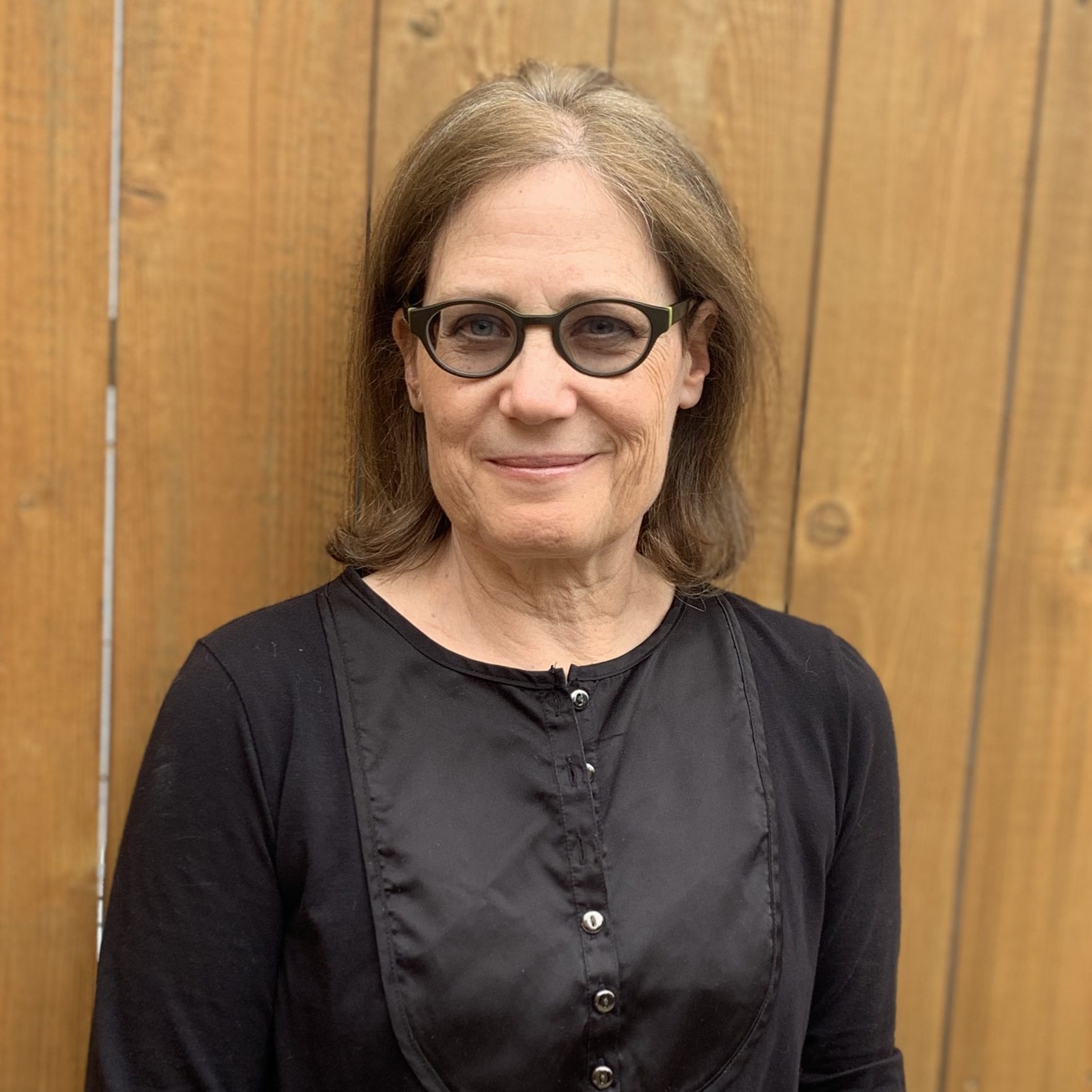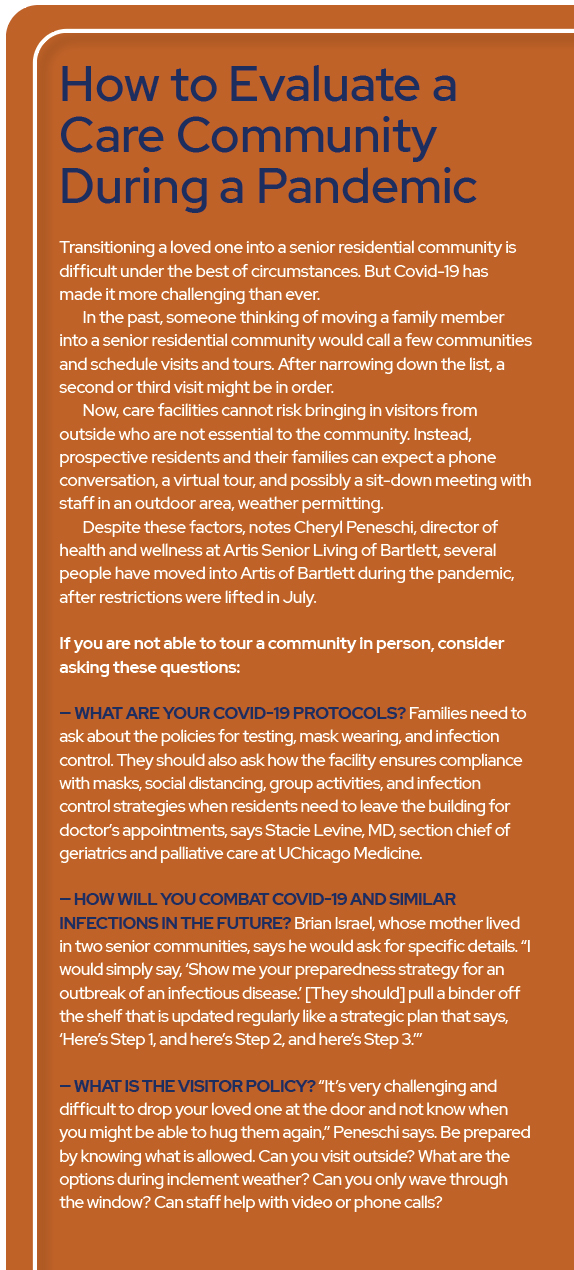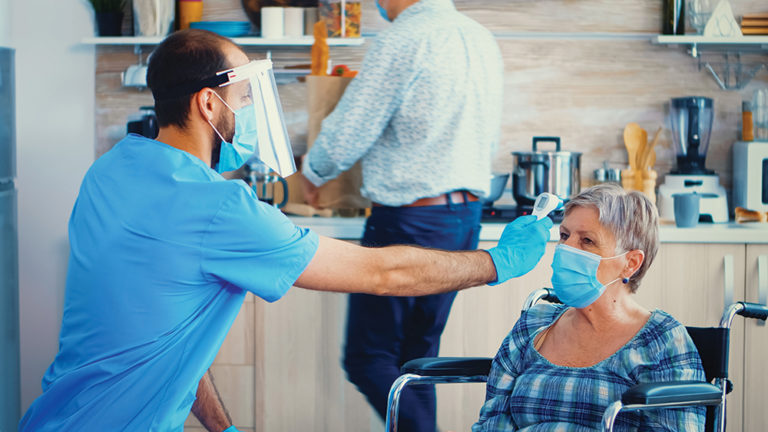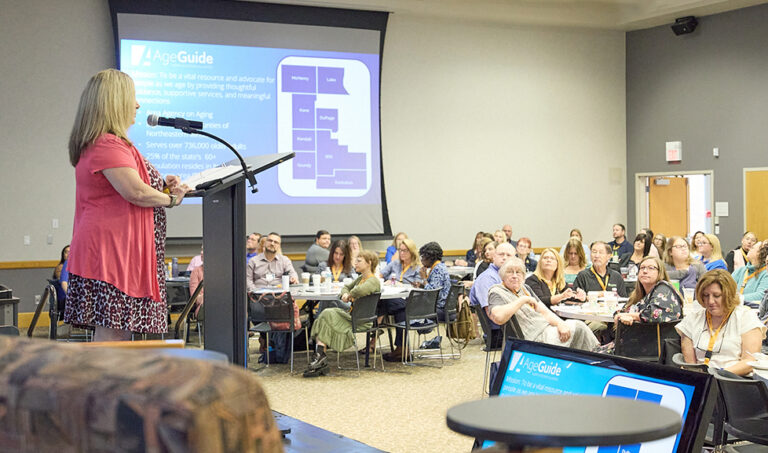
Ronit is a freelance writer, based in Chicago. She has a special interest in health, healthcare and preventive medicine.
Senior residential communities face pandemic’s tough lessons
At this time last year, family members could pop in at any time to see their loved ones living in a senior residential community. They could relax, catch up, and enjoy a meal together. That feels like a distant world now — and at this point, nobody knows when it will return. As care communities change and adapt in the face of Covid-19, residents and families have had to adapt too.
Covid-19’s deadly blow has impacted long-term care communities of all types, in some cases ravaging them. Illinois has approximately 1,200 long-term care communities. As of mid-November, more than half of the state’s Covid-19 deaths had been in those facilities, according to the Illinois Department of Public Health.
While older adults are at a high risk of Covid-19 due to age and illness, senior care communities have their own challenges that have made them particularly vulnerable, especially during the early days of the pandemic.
These communities have had to deal with shifting public health guidelines, a lack of personal protective equipment (PPE), and a shortage of staff. With staff and visitors coming and going, the virus has spread in communal settings.
Many people within the long-term care industry — including Bob Gallo, AARP Illinois state director — agree that Covid-19 has highlighted just how much the industry needs to be revamped. But how, or if, that will happen, or who will lead the charge, is less certain. For now, communities continue to learn how best to face the virus, while dedicated staff members care for seniors in creative new ways.
Initial impact
The pandemic’s initial months hit care communities especially hard, though they fared better in subsequent months. From March to May, 2,747 long-term care workers and residents had died from Covid-19 in Illinois. The rate slowed but was still significant as the pandemic progressed, with more than 5,000 deaths in Illinois facilities by mid-November.
When the coronavirus first struck in spring, many communities were not prepared, says Stacie Levine, MD, section chief of geriatrics and palliative care at UChicago Medicine.
“We did not have a lot of PPE back in late March through April. That really put buildings in a vulnerable state,” she says. “The lack of PPE and the lack of testing was a huge risk factor for the disease spreading rapidly through these buildings.”
Covid-19 has taken a toll on many care communities across the state. However, a facility’s infection rate doesn’t necessarily correlate with its quality, Levine says. “You could have a high-level, five-star building and still have an enormous outbreak.”
The virus has especially impacted some long-term care communities with large minority populations, Levine says, consistent with data showing that Covid-19 disproportionately affects Black and Latino communities.
The need for collaboration
As the pandemic continues, care communities are looking to make communal living situations safer for seniors, safeguarding the well-being of residents and staff while reducing their social isolation.
Covid-19 has proven that long-term care facilities need support. They are not hospitals equipped with medical-grade isolation rooms, and most of them cannot offer critical care to residents. The care communities need increased information, guidance, and cooperation with local hospitals and public health departments.
The long-term care setting, as a whole, was not prepared for this, says Apsara Rosario, assistant director of nursing at Alden Terrace of McHenry, which suffered an outbreak among residents and staff. “Now that we know what we are dealing with, we need all the help we can get,” she says.
Rosario suggests that personnel in long-term care settings should be better trained in acute care. “From my experience, I think that, early on, there needs to be some type of working hand-in-hand,
not just with the local health department but also with the local hospital,” she says.
In Bartlett, even though the long-term care communities are “friendly competitors,” they learned from each other and from local officials during the pandemic, says Donna Germann, senior executive director of Artis Senior Living of Bartlett.
The Bartlett fire district, which is responsible for sending paramedics and ambulances to care communities, organized a twice-weekly call with the police department and senior living communities in Bartlett.
“We all talked about what was happening in our buildings. They gave us an update on what was going on in the hospital, what the bed capacity was. So we had the support of the community,” Germann says.
Bartlett Fire Chief William Gabrenya says he was excited about the collaboration among senior communities. “They were sharing emails on different resources about where they could get supplies, how they each were handling new Covid patients, and employment issues. It was nice for them to share information and share resources.”
Others are collaborating in different ways. At Artis Senior Living, which has corporate headquarters in Virginia, staff partnered with Johns Hopkins University to get the most up-to-date information on Covid-19. Artis holds regular virtual safety council town hall meetings with its Hopkins partners and posts links to the meetings on its website for all to see and learn.

Important lessons
Nearly a year into the pandemic, the collective Covid-19 experience has revealed important takeaways for senior residential communities.
Every community needs to invest in PPE and to have several months on hand, readily accessible, says Cheryl Peneschi, director of health and wellness at Artis Senior Living of Bartlett. “It is the common mandate that we keep a specific inventory on hand for possible future outbreaks,” she says.
The standard now is for communities to have two months’ worth of PPE on hand or readily available, Levine says. “PPE is a huge thing to have,” she says.
Communities also need to think creatively and long-term about establishing safe ways to prevent social isolation. Many older adults have been cut off from their extended families for months, weakening the social support and connections that are important for good health.
Most communities suspended in-person visits at the start of the pandemic, finding alternatives, such as visits through a window or video calls. During summer, many facilities allowed socially distant visits outdoors.
But at some communities, even outdoor visits have been challenging, says Gallo at AARP. “There are some facilities that have lovely grounds, where you can sit on a bench under a shaded tree or in a gazebo, but that may not work in every situation where the best you have is a parking lot,” he says.
Certainly, visiting policies are changing over the cold winter months and will be a major issue for some time. Communities will need to find ways to safely hold indoor activities and family visits, Levine says.
“I hope that each senior living community is trying to think about this right now and trying to be creative, [to] think about recreational activities that will bond people together and be more inclusive of their loved ones,” she says.
Looking to the future
How are things going to change in the future? “I think that book is going to be written on what really needs to be changed, what really is the best model for individuals who are aging and those who cannot take care of themselves,” Gallo says.
And he has questions on those specifics. If the long-term care industry were going to attempt to revamp itself in the wake of Covid-19, Gallo wonders: “Are there other models, not only in this country but in other countries, of how we care for people? What is federal, state, and local government’s responsibility? What are individuals’ responsibilities to be prepared for having to be taken care of in their older years if they cannot take care of themselves or if family members are unable or unwilling to take that responsibility?”
On the positive side, the pandemic has brought some much-needed attention to the work of staff at senior residential communities. Throughout the brunt of the pandemic, staff members have been working extremely hard, caring for others despite their own personal risk.
“I think it is dreadfully hard on the management and staff who take seriously their responsibility to care for these fragile people,” says Chicago resident Brian Israel, whose mother lived in two long-term care communities in the Chicago area before she passed away in fall at the age of 96.
“I have so much admiration for them, just for the work they do under normal circumstances,” he says, “but in a situation like this, to keep their morale up and continue doing this work in the safest possible way — they are truly heroic figures.”













